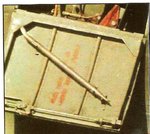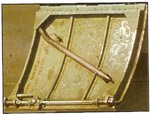Navigation
Install the app
How to install the app on iOS
Follow along with the video below to see how to install our site as a web app on your home screen.
Note: This feature may not be available in some browsers.
More options
You are using an out of date browser. It may not display this or other websites correctly.
You should upgrade or use an alternative browser.
You should upgrade or use an alternative browser.
RAF Markings and Camouflage (1 Viewer)
- Thread starter Micdrow
- Start date
Ad: This forum contains affiliate links to products on Amazon and eBay. More information in Terms and rules
More options
Who Replied?- Thread starter
- #3
Thanks a lot for the reply, The image posted will be of some help, and I will probably have to make some revisions now, but what I was hoping to find was a list/position of the myriad of small stencils that are found all over the Spitfire.
I have just found this image on-line. and I am looking for something similar, but port side and clearer, and maybe any colour differences if any.
Does anybody know if these stencils are model specific or are they pretty much the same across all marks?
I know I don't ask much
cheers
I have just found this image on-line. and I am looking for something similar, but port side and clearer, and maybe any colour differences if any.
Does anybody know if these stencils are model specific or are they pretty much the same across all marks?
I know I don't ask much
cheers
Attachments
Hi,
Unfortunately,your pic is a bit unreadable.But judging by the the places where these exploitation symbols are visible I say, yes.For early Spitfires,I mean Mk.I-V these stencils were painted exactly at those places.For later ones I'm not sure.In many pics of Mk.IX and others later these marks are visible at the same places or unvisible at all.
regards,
Unfortunately,your pic is a bit unreadable.But judging by the the places where these exploitation symbols are visible I say, yes.For early Spitfires,I mean Mk.I-V these stencils were painted exactly at those places.For later ones I'm not sure.In many pics of Mk.IX and others later these marks are visible at the same places or unvisible at all.
regards,
Wurger thanks for the reply,
I have contacted the website that I obtained the image from my previous post and i'm attempting to get a higher rez copy, I guess I cant really go to wrong if I use this as a guide.
I thought I might post an image, to better explain why I want to find these details. here's very much a work in progress.
cheers.
I have contacted the website that I obtained the image from my previous post and i'm attempting to get a higher rez copy, I guess I cant really go to wrong if I use this as a guide.
I thought I might post an image, to better explain why I want to find these details. here's very much a work in progress.
cheers.
Attachments
Gadget, not sure if you are referring to my work but the picture you posted isn't one of mine (nice as it is) I am pretty new to profile creation and have been only been working up to this for a little while.
If anybody is interested some of my other profiles can be viewed here.
jb's profiles MKIV - Warbirdz.Net Forum
If anybody is interested some of my other profiles can be viewed here.
jb's profiles MKIV - Warbirdz.Net Forum
Wurger thanks for the reply,
I have contacted the website that I obtained the image from my previous post and i'm attempting to get a higher rez copy, I guess I cant really go to wrong if I use this as a guide.
I thought I might post an image, to better explain why I want to find these details. here's very much a work in progress.
cheers.
Hallo Profiler,
Looking at your shot of the profile I say well done M8.
Is this Spit the Mk.XII or Mk.XIV?.Undoubtedly powered with a Griffon engine.
I've tried to find something else for those variants but with no success.
von Pwnage
Recruit
- 4
- Nov 20, 2007
I have a random question. The bomb decals on the side of RAF bombers, do they represent the payload of the bomber or the bombing hits the the pilot has made?
- Thread starter
- #12
I have a random question. The bomb decals on the side of RAF bombers, do they represent the payload of the bomber or the bombing hits the the pilot has made?
Usually the bomb decal on the side of the aircraft represents the number of mission's that bomber has flown.
- Thread starter
- #14
- Thread starter
- #15
von Pwnage
Recruit
- 4
- Nov 20, 2007
Thanks for the info and images.
von Pwnage
Recruit
- 4
- Nov 20, 2007
Thanks for info and pix.
Wurger thanks for the reply,
I have contacted the website that I obtained the image from my previous post and i'm attempting to get a higher rez copy, I guess I cant really go to wrong if I use this as a guide.
I thought I might post an image, to better explain why I want to find these details. here's very much a work in progress.
cheers.
Crowbars (only fitted to Spitfires from the Mk V onwards) were not painted red until after the war. During the war they were either silver (steel) or Interior Green, perhaps sometimes black). Its purpose was to help the pilot extract himself from the cockpit after an accident. After the war international agreements on safety decreed that safety equipment be painted red and the crowbar was considered to be an item of safety equipment. The rules are probably still in place which is why warbirds and museum examples have red crowbars.
The stencilling on the door comes in several variations and can also differ from factory to factory. It was invariably red. Often written upright and upside down so that it could be read from inside (looking down) and outside the cockpit.
Attachments
Good example of kill markings for a british aircraft. Source of picture is from the book Fighter Command 1939-1945 by Ian Carter.
On the 30th July 1944 315 Squadron undertook a mission to Norway from which they returned with eight victories shard between 6 pilots. The Polish Film Unit visited Brenzett between the 1st and 3rd of August and took a number of publicity photographs (as well as filming) of the six pilots and Horbaczewski's Mustang. The four swastikas denote his V1 kills. The bomb mission markings were yellow not white as they are frequently depicted. Such markings are found on Polish squadron Mustangs and Spitfires but I have not seen much evidence that they were used by RAF squadrons.
Like all Polish squadrons, 315 Squadron belonged to the Polish Air Force (PAF) not the RAF. The PAF was an independent air force integrated with the RAF and over which the RAF had operational control. Personnel had both PAF and RAF ranks but swore allegiance only to the Polish Republic not King George VI. All equipment had to be purchased from the British Government and payment was taken from Polish gold reserves in Canada after the war.
Below, the six pilots and two ground crew.
Attachments
- Thread starter
- #20
On the 30th July 1944 315 Squadron undertook a mission to Norway from which they returned with eight victories shard between 6 pilots. The Polish Film Unit visited Brenzett between the 1st and 3rd of August and took a number of publicity photographs (as well as filming) of the six pilots and Horbaczewski's Mustang. The four swastikas denote his V1 kills. The bomb mission markings were yellow not white as they are frequently depicted. Such markings are found on Polish squadron Mustangs and Spitfires but I have not seen much evidence that they were used by RAF squadrons.
Like all Polish squadrons, 315 Squadron belonged to the Polish Air Force (PAF) not the RAF. The PAF was an independent air force integrated with the RAF and over which the RAF had operational control. Personnel had both PAF and RAF ranks but swore allegiance only to the Polish Republic not King George VI. All equipment had to be purchased from the British Government and payment was taken from Polish gold reserves in Canada after the war.
Below, the six pilots and two ground crew.
Very cool info antoni, I missed that, thanks for the correction
Users who are viewing this thread
Total: 2 (members: 0, guests: 2)
Similar threads
- Replies
- 3
- Views
- 239










